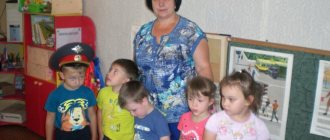Summary of the parent meeting on the topic “Children’s safety on the road”
Author: Kruglikova Olga Stepanovna
Summary of the parent meeting in the preparatory group
Parent meeting in the preparatory group on the topic “Children’s safety on the road.”
Author: Olga Stepanovna Kruglikova, teacher at MBDOU No. 90, Kemerovo.
Target:
Pedagogical education and involvement of parents in the process of teaching preschoolers the skills of safe behavior on the roads and streets of the city, developing a sense of responsibility for the life and health of their children.
Tasks:
— Familiarize parents with the theoretical foundations of road safety. — To create motivation in parents to self-develop a culture of safe behavior for children on the streets and roads. — Create conditions for interaction with society to prevent road traffic injuries among preschool children.
Parent meeting agenda:
1. Opening remarks. 2. Message from the group teacher. 3. Recommendations for parents on teaching children traffic rules.
4. Distributing a handout for parents “What can I do?”
Progress of the parent meeting:
1. Opening speech by the teacher:
“Our children were born to live joyfully. To play together, to be strong friends, to give smiles to each other and flowers, so that dreams always come true in their lives.”
Yes, our children are born precisely for this, but whether this always happens, whether life will be overshadowed by tragedy - this largely depends on us, adults. The topic of today's meeting is “Children's safety on the road.” The need for a meeting on traffic rules is dictated by life itself. The terrible statistics of child mortality and health damage as a result of road accidents are simply terrifying. And most often we, the adults, are to blame for tragedies. At this meeting we will talk about what parents can do to keep their child safe on the road. First of all, parents should understand that this task of protecting their child on the road is fundamentally unsolvable. Firstly, any movement by transport (and even on your own feet) is associated with danger, and the probability of the unexpected happening is always different from zero. This was not said at all to scare parents, but on the contrary, to draw their attention to the fact that you should always take care of the children’s safety (and your own). Secondly, the task of protecting the child once and for all cannot be solved, because the child is growing, and the possible dangers that await him on the road are growing. Therefore, children should be promptly taught the ability to navigate a traffic situation, cultivate the need to be disciplined on the street, careful and prudent. And parents should not make the most common mistake - acting on the principle “you can do it with me.” If you show your child by your own example how to run to red, be sure that when left alone, he will try to repeat this trick. Dear parents! Remember, if you break the Rules, your child will do the same! We have the power to develop the skills of safe behavior on the roads, to educate a conscious and competent pedestrian, responsible for the life and health of road users.
2. Message from the group teacher.
Today's children have to live with incomparably more aggressive traffic, and therefore every day it is becoming more and more difficult to ensure their safety. It is very important from preschool age to develop in children the skills of safe behavior on the road and to raise law-abiding citizens. Our task is to develop in children an understanding of the dangers that the automotive world conceals. It is important to do this before the child adopts and accepts the wrong stereotypes of behavior on the road, which, unfortunately, are currently prevalent in the adult environment. The study of traffic rules in kindergarten takes place in special classes, during games (didactic, active, role-playing), entertainment, etc. The topic of traffic rules covers not only educational, but also other types of classes - mathematics, familiarization with fiction, arts and crafts, physical education, etc. In classes, children learn to navigate in space, simulate various situations on the road, and play them out. We also form motor skills in children: children must not only move correctly in accordance with the received signal or, focusing on an adult, but also be able to coordinate their movements with the movement of other people and the movement of objects. In addition, with the help of didactic games we try to develop voluntary, active attention, because For safe behavior on the streets, it is necessary to develop in children voluntary attention and the ability to concentrate on the road situation. Preschool children are a special category of pedestrians and passengers. They cannot be approached with the same standards as adults, so there is a need to create a certain system to familiarize children with traffic rules and instill in them the skills of safe behavior on the roads and streets of various settlements. It is safe to say that work in this area is being carried out quite effectively, since for several years now no violations or accidents involving pupils of our kindergarten have been recorded. Our goal is not only to give children knowledge about the rules of the road, but also to develop in them the skills to adequately apply this knowledge in various situations, so that these skills develop into a habit.
3. Recommendations for parents on teaching children traffic rules.
Let me remind you once again of the basic rules that a child should know:
1. Basic terms and concepts of the rules. 2. Responsibilities of pedestrians. 3. Responsibilities of passengers. 4. Traffic regulation. 5. Traffic lights. 6. Warning signals. 7. Traffic across railway tracks. 8. Traffic in residential areas and transportation of people. 9. Features of cycling.
Remember! The child learns the laws of the roads, following the example of family members and other adults. Don't waste time teaching your children how to behave on the road. To prevent your child from creating a dangerous situation on the roads, he must be able to: • watch the road; • correctly assess the road situation in all its variability; • see, listen, anticipate, avoid danger.
Watch the road.
1. It is necessary to teach children not only to follow the traffic rules, but also from a very early age to teach them to observe and navigate. It must be taken into account that the main way to develop behavioral skills is through observation and imitation of adults, especially parents. 2. When you are on the roadway with your child, do not rush, cross the road at a measured pace. Otherwise, you will learn to rush where you need to watch and ensure safety. 3. Teach your child to notice a car. Sometimes a child does not notice a car from afar. Teach him to peer into the distance. 4. Teach your child to estimate the speed and direction of the future movement of the car. Teach your child to determine which one is going straight and which one is preparing to turn. 5. Teach your child to watch. The habit of inspecting the street in both directions should be brought to automaticity before taking the first step from the sidewalk to the roadway. You need to look especially carefully at the street when there is a family home or acquaintance on the opposite side, or when a child crosses the street with other children - it is in these cases that it is easy to miss the car.
Correctly assess the road situation.
The main danger is a stationary car. Why? Yes, because having seen the approaching car in advance, the pedestrian will give way to it. A stationary car deceives: it can block a moving one, preventing you from noticing the danger in time.
Rule #1.
You cannot go out onto the road because of parked cars. As a last resort, you need to carefully look out from behind a standing car, make sure that there is no danger, and only then cross the street. Watch with your child the cars standing at the edge of the roadway and pay attention to the moment when another one suddenly appears from behind the standing car. Draw your child's attention to the fact that a bus standing at a stop also makes it difficult to see the car moving behind it.
Rule #2
You need a parked bus neither in front nor behind! A standing bus, no matter how you go around it - in front or behind, covers a section of the road along which a car can pass at the moment when you decide to cross it. In addition, people near the bus stop are usually in a hurry and forget about safety. We have to wait until the bus leaves.
Rule #3
And at the traffic lights you can meet danger! Children often reason like this: “The cars are still standing, the drivers see me and will let me through.” They are wrong. Immediately after turning on the green signal for drivers, a car that was not visible behind the standing cars and whose driver cannot see the pedestrian may enter the crossing. If the green traffic light for pedestrians goes out, you need to stop. The child must not only wait for the right light, but also make sure that all the cars have stopped.
Rule #4
Develop in your child the habit of always stopping, looking around, listening before going out on the road, even if there are no cars on it, and only then cross the street.
Rule #5
Strong transport behavior skills in children are formed only through daily systematic training! During every walk with children, trips with them on business, to visit, out of town, etc. teach them to observe the street and transport, analyze the road situations encountered, see dangerous elements in them, and act accurately in various circumstances.
Rule #6
There is no need to instill in children an excessive sense of fear of traffic and moving cars. Let everything that is connected with kindergarten (and later school), including the road, be associated with the bright and kind in the child. At the same time, you need to teach him to be attentive, and this is not an easy thing. The processes of perception, attention and reaction in a child and an adult are completely different. Experienced drivers know, for example, that sounding the horn when they see a child running across the road is dangerous. The child may act unpredictably - instead of stopping, he may rush without looking back under the wheels of another car. Even those children who know the rules of the road sometimes break them. Don't take the trouble to help the children. You may have to stop a child who doesn't want to wait for a traffic light. Do it kindly.
4. Distribute reminders for parents “What can I do?”
Memo “What can I do?” (Appendix No. 1) will tell you what parents can do to keep their child safe on the road.
So, if you teach your children to follow these basic rules of behavior on the roads, then trouble will not come to your home.
In conclusion, it is worth noting that studying traffic rules is just as necessary as studying basic subjects (mathematics, Russian language). After all, the safety of our children’s lives is no less important than the indicator of their intellectual development, and even much more significant. When teaching a child the rules of the road, an adult must clearly understand what needs to be taught and how to do it more effectively. He himself must be well versed in road situations. Therefore, you should not only analyze your life experience in advance, but also study the necessary literature on the topic “Road Rules”. What and, most importantly, how well we teach a child, what skills of safe behavior on the street we instill in him, will protect him all his life. Attached files: comments powered by HyperComments
PROTOCOL OF PARENTS MEETING “Prevention of child road traffic injuries”
PROTOCOL No. 6
PARENT MEETING in grade 2 "A"
“16” February 2016 Time 18.00. office 1-11
The number of students on the list is 24 people.
Number of parents present: 21 people.
PARENT MEETING AGENDA:
1. Lecture on the theme of the meeting “The Secret World of Our Children, or the Child and the Street.” 2. About nutrition and vitaminization in the spring. About the incidence of ARVI and influenza. 3. Prevention of children's road traffic injuries. 4. Miscellaneous.
LISTENED TO:
On the first question
Psychologist L. V. Vedmenskaya gave a lecture.
The meaning of friends and friendship in the life of a child of primary school age. Age-related characteristics of the perception of friendship by a child of primary school age. The child’s position in the group and his sense of self. Popular and unpopular children in the team. Reasons for a child’s popularity and unpopularity among peers. Comfort and discomfort of the child. Positive and negative effects of the company's influence on a child of primary school age. Loneliness of a child. Child's problems in choosing friends. Parental behavior strategy: tact, correctness, desire to understand and help. We decided:
the lecture took place, take note of the information.
On the second question
A doctor spoke and reminded that vitamins are very important in the life of the body, and their deficiency or absence causes serious health problems.
The child’s body is especially sensitive to vitamin deficiencies. And here the question was raised that, according to Rospotrebnadzor, as a result of a decrease in immunity, an increase in the incidence of ARVI and influenza is predicted. Follow preventive measures against influenza. We decided
to take note of the information and include vitamin-rich foods in our diet.
On the third question
class teacher O.N. Trashchenko spoke. Forms of work on the prevention of children's road traffic injuries at school were presented: individual conversations, consultations, games, classes on this topic, lessons and more. A film was shown about childhood injuries, the causes of child mortality on the roads, and the need to use special child restraints for personal cars.
The chairman of the parent committee Tikhonova M.K. spoke - “Flickers and the safety of children on the roads.”
A pedestrian with a flicker is visible in the headlights of a car from a distance of up to 400 m! Wearing a flicker reduces the risk of hitting a pedestrian at night by 6 times. Flickers save lives. Flicker is a retroreflector that can save a pedestrian or child on the road. Providing visibility in low light conditions, a reflector becomes practically the only way to identify yourself on the roadway.
Decided:
1. Activate and improve the work of students in the prevention of child road traffic injuries.
2. Take note and follow the information for parents (legal representatives) about the use of child restraint devices (for drivers of private cars).
3. Buy flickers and hang them on the backpack of each student in the class.
.
Secretary:
Zapotylok I.A.
Classroom teacher:
Trashchenko O.N.




